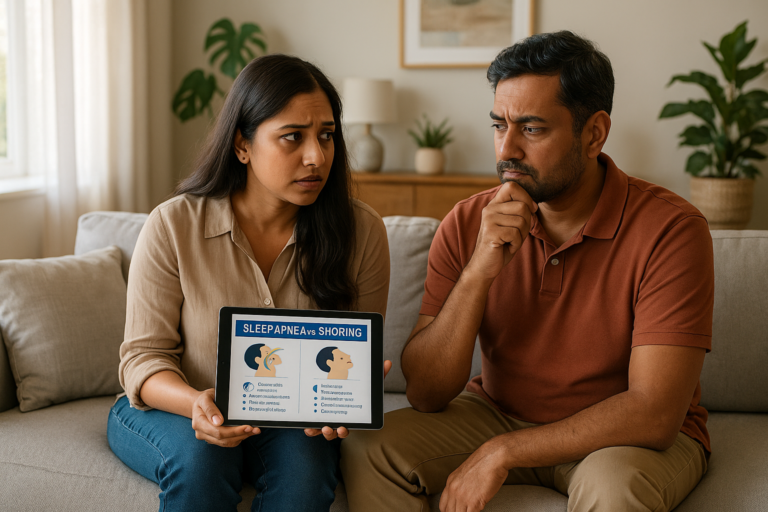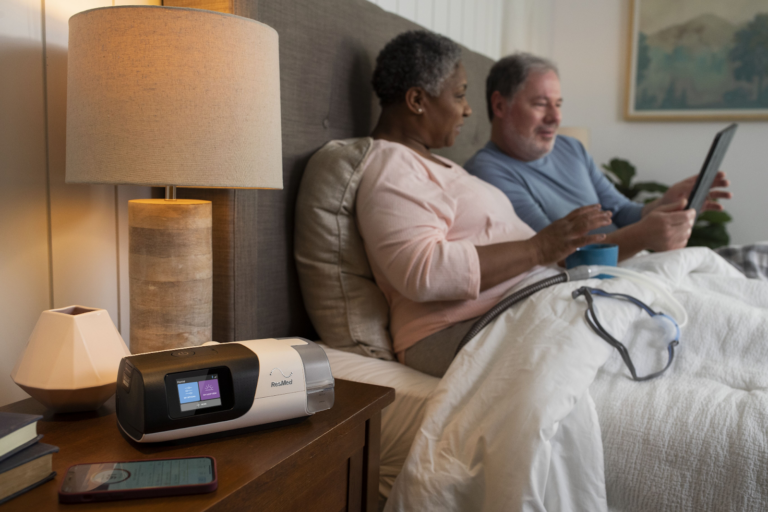Your cart is currently empty!
Prefer to just call? (07) 3472 6421
|
Sleep Apnea vs Snoring: How to Tell the Difference and When to Seek Help

Many Australians snore, but not every snore means the same thing. For some, it’s just noise caused by relaxed throat muscles. For others, it’s a sign the body is struggling to breathe. Knowing which applies to you can make a major difference to your health and energy.
Understanding the distinction between snoring and sleep apnea helps you act early and avoid years of poor-quality rest. At Sleep Warehouse, we support Australians who have been diagnosed with sleep apnea by helping them choose comfortable, effective CPAP therapy equipment that fits their lifestyle.
What’s the Difference Between Snoring and Sleep Apnea
Snoring occurs when air moves through a partially narrowed airway during sleep, causing soft tissues in the throat to vibrate. It’s common and usually harmless.
Sleep apnea, however, happens when the airway becomes blocked or collapses entirely. Breathing stops for several seconds and can repeat dozens of times through the night. These pauses lower oxygen levels and interrupt deep sleep, even if you don’t fully wake.
| Snoring | Sleep Apnea | |
| Airway | Narrowed but open | Partially or fully blocked |
| Sound | Steady snore | A loud snore followed by silence or gasping |
| Impact | Mild disturbance | Reduced oxygen and fragmented sleep |
| Main concern | Noise | Long-term health effects |
Many people can’t tell the difference themselves. Often, it’s a partner who first notices pauses or choking sounds. There are also milder forms, such as upper airway resistance, where breathing becomes strained without complete blockage but still leads to fatigue.
Recognising the Signs
Sleep apnea doesn’t always look dramatic. It can build slowly, starting with restlessness or mild tiredness before progressing into daily fatigue and concentration issues.
Signs Linked to Sleep Apnea
✔ Breathing pauses or gasping during sleep
✔ Morning headaches or dry mouth
✔ Daytime tiredness, poor focus, or irritability
✔ Unrefreshing sleep despite spending enough hours in bed
✔ High blood pressure or frequent night-time awakenings
Signs Linked to Typical Snoring
✔ Loud, steady snoring that doesn’t interrupt breathing
✔ Feeling alert and rested after sleep
✔ No sudden awakenings or choking
✔ Partner notices noise but no breathing pauses
Overlapping Symptoms
✔ Restless sleep and mild tiredness
✔ Occasional snorts or brief awakenings
If you consistently wake up tired, even when you’ve had enough rest, it’s best to have your sleep assessed. Early attention prevents long-term strain on your health.
Why It’s Important to Check
Sleep apnea affects more than how you feel in the morning. When oxygen levels drop repeatedly, the heart and blood vessels work harder. Studies from the Sleep Health Foundation link moderate to severe apnea with higher risks of hypertension, heart disease, and reduced alertness, all of which can affect daily safety, particularly for drivers and shift workers.
Even mild sleep apnea can limit your ability to focus, remember details, or manage stress. Treating it improves energy, mood, and overall well-being.
Snoring, while less severe, still impacts quality of life. It disrupts partners, dries the throat, and worsens with age or weight gain. If the sound is becoming louder or more frequent, it’s worth discussing with your GP.
Did You Know?
Around one in ten Australians lives with undiagnosed sleep apnea. Most only realise something’s wrong after years of poor sleep or complaints from partners. Early testing helps confirm the cause and identify effective solutions.
How Diagnosis Works
Getting tested is straightforward and can often be done at home.
Home Sleep Testing
A home sleep test measures oxygen levels, heart rate, and breathing patterns overnight. You’ll wear small sensors on your finger, chest, and under your nose. Results are usually reviewed within a few days by a qualified clinician.
In-Clinic Sleep Study
For complex or unclear cases, a supervised overnight study (polysomnography) records brain waves, muscle activity, and airflow. It’s more detailed and helps confirm the severity of apnea.
After the Results
Your GP or sleep specialist will explain the findings and discuss treatment options. If CPAP therapy is recommended, Sleep Warehouse can assist with machine selection, mask fittings, and setup guidance. We also provide ongoing customer support for therapy comfort and maintenance.
Treatment and Management Options
CPAP Therapy
Continuous Positive Airway Pressure (CPAP) therapy keeps your airway open using gentle airflow through a mask. It’s the gold-standard treatment for obstructive sleep apnea and is highly effective when used consistently.
Modern CPAP devices, such as the ResMed AirSense 11 AutoSet, automatically adjust pressure during the night for comfort and reliability. They’re quieter, easier to travel with, and built for long-term use.
At Sleep Warehouse, we stock the full range of ResMed CPAP machines, masks, and accessories. Our team helps customers choose setups that fit their needs and budget.
Oral Appliances
For mild to moderate cases, dentist-made oral devices reposition the jaw to reduce airway collapse. These can help when CPAP isn’t tolerated, though follow-up sleep studies are still essential to confirm results.
Lifestyle Adjustments
Some daily changes can significantly improve symptoms:
✔ Maintain a healthy weight to reduce neck pressure
✔ Avoid alcohol or sedatives before bed
✔ Sleep on your side to keep airways open
✔ Keep nasal passages clear with saline rinses or nasal strips
✔ Stick to consistent sleep and wake times
Combining healthy habits with proper therapy often delivers the best results.
Everyday Habits That Support Better Sleep
Good habits improve both general sleep quality and CPAP effectiveness.
✔ Keep your room cool and ventilated: Warm rooms relax airway muscles.
✔ Limit caffeine after midday: It blocks melatonin, delaying sleep onset.
✔ Follow a routine: Your body performs better with consistent sleep times.
✔ Clean and replace CPAP components as recommended: Hygiene affects comfort and machine performance.
✔ Stay active during the day: Regular exercise enhances deep sleep cycles.
These simple changes make therapy more comfortable and long-term results easier to maintain.
When to Seek Help
If you snore loudly, wake up choking, or feel exhausted despite sleeping enough hours, see your GP. They can organise a home test or refer you to a sleep specialist.
A first appointment usually covers sleep habits, daytime symptoms, and any related health concerns. Testing is easy to arrange and gives you a clear diagnosis. Most people notice improved energy and alertness within weeks of starting treatment.
Wearables can help you notice patterns, but can’t confirm sleep apnea. A professional sleep study remains the only accurate method.
Understanding the Difference Helps You Sleep Better
Snoring might seem minor, but ongoing fatigue or disturbed breathing shouldn’t be ignored. Identifying whether it’s simple snoring or sleep apnea is the first step to better rest and long-term health.
Once diagnosed, the right CPAP setup can restore proper breathing and help you wake up feeling refreshed.
Sleep Warehouse supports Australians with trusted ResMed CPAP machines, masks, and accessories, along with expert advice to help you stay consistent with your therapy.
Explore the latest range at Sleep Warehouse and step toward better, quieter sleep.
FAQs
1. How long does it take to get used to CPAP therapy?
Most people adjust within a few weeks once their mask fit and air pressure are set correctly. Starting with shorter sessions during the day helps your body adapt. Sleep Warehouse offers setup guidance, fitting tips, and support calls to make the transition smoother.
2. Can untreated snoring turn into sleep Apnea over time?
Snoring itself doesn’t automatically lead to sleep apnea, but factors like weight gain, ageing, or increased airway restriction can raise the risk. If snoring changes or tiredness worsens, Sleep Warehouse can help you understand the next steps and connect you with the right therapy options once a diagnosis is confirmed.
3. What happens if I travel with a CPAP machine?
Modern CPAP machines, including compact travel-friendly options, are designed for easy packing and in-flight use. Sleep Warehouse stocks lightweight ResMed models that meet airline standards and offers travel accessories to keep your therapy consistent while away.
4. How do I know if my CPAP machine needs replacement or servicing?
Most CPAP machines last about five years when maintained properly. Signs it’s time for servicing include unusual noise, weak airflow, or visible wear. Sleep Warehouse provides after-sales support, replacement filters, and upgrade advice to keep your therapy equipment performing at its best.
ABOUT AUTHOR



Leave a Reply
You must be logged in to post a comment.